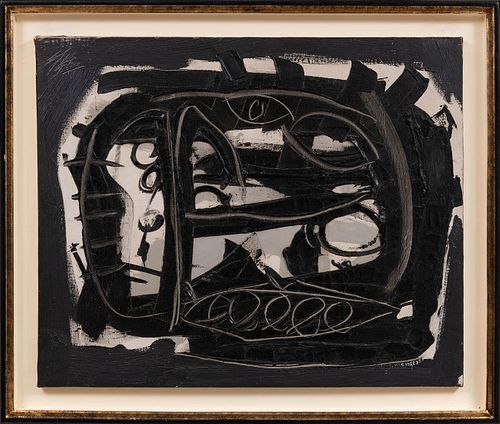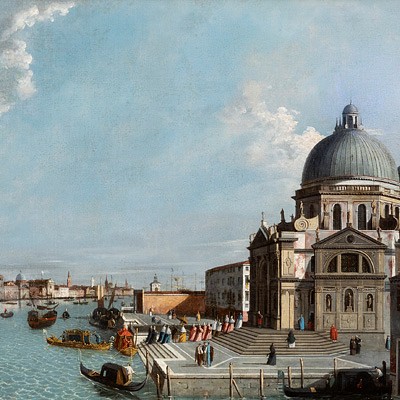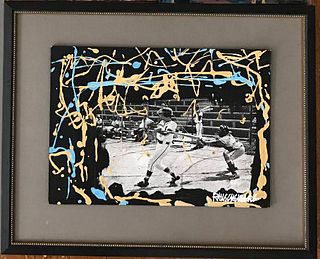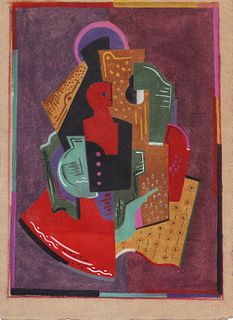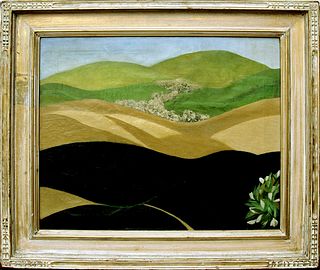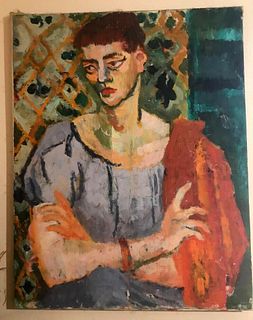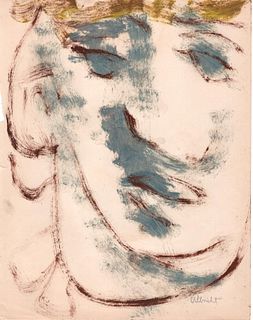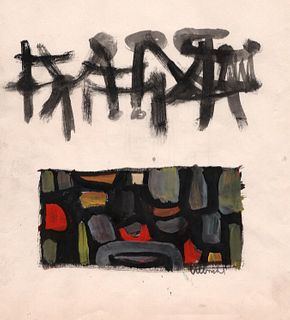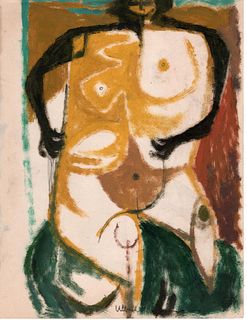ANTONIO SAURA (Huesca, 1930 - Cuenca, 1998). "Portrait Num. 112", 1960. Oil on canvas. Provenance: Pierre Matisse Gallery collection, New York (lab
Lot 52
About Seller
Setdart Auction House
Carrer Aragó 346
Barcelona
Spain
Setdart Subastas was born in 2004 and is currently the first online art auction in Spain with solidity, prestige and reliability guaranteed by our more than 60,000 users. Setdart has a young, dynamic and enterprising team ready to successfully manage the purchase and sale of art works through custom...Read more
Estimate:
EUR€45,000 - EUR€50,000
$48,387.10 - $53,763.44
Absentee vs Live bid
Two ways to bid:
- Leave a max absentee bid and the platform will bid on your behalf up to your maximum bid during the live auction.
- Bid live during the auction and your bids will be submitted real-time to the auctioneer.
Bid Increments
| Price | Bid Increment |
|---|---|
| EUR€0 | EUR€10 |
| EUR€200 | EUR€25 |
| EUR€500 | EUR€50 |
| EUR€1,000 | EUR€100 |
| EUR€3,000 | EUR€200 |
| EUR€5,000 | EUR€500 |
| EUR€10,000 | EUR€1,000 |
| EUR€20,000 | EUR€2,000 |
| EUR€50,000 | EUR€5,000 |
About Auction
By Setdart Auction House
May 18, 2021
Set Reminder
2021-05-18 09:30:00
2021-05-18 09:30:00
America/New_York
Bidsquare
Bidsquare : Classics XIX and XX
https://www.bidsquare.com/auctions/setdart-auction-house/classics-xix-and-xx-6961
The next 18th May there will be a 19th and 20th Century Classics Auction at Setdart.com There will be a select repertoire of important artists such as Carlos Cruz Diez, Luis Feito, Joan Miró, Fernando Botero, Josep Llimona, Salvador Dalí among others. Setdart Auction House sofia@setdart.com
The next 18th May there will be a 19th and 20th Century Classics Auction at Setdart.com There will be a select repertoire of important artists such as Carlos Cruz Diez, Luis Feito, Joan Miró, Fernando Botero, Josep Llimona, Salvador Dalí among others. Setdart Auction House sofia@setdart.com
- Lot Description
ANTONIO SAURA (Huesca, 1930 - Cuenca, 1998). "Portrait Num. 112", 1960. Oil on canvas. Provenance: Pierre Matisse Gallery collection, New York (label on the back). Attached Certificate of Authenticity from the Antonio Saura Foundation (Cuenca). Measurements: 60 x 73 cm; 73 x 86 cm (frame). In 1960, Saura began a series of paintings he called "imaginary portraits", dedicated to different historical figures. At the same time, he would make portraits not inspired by a specific character but by emotions condensed in a quasi-abstract expression. In general, portraits are the great theme of this great creator framed within abstract expressionism, but who never abandoned the figurative element. The face we are dealing with is practically undone, but we recognize the eyes, the nose, the mouth... The factions emerge as those of a spectrum pregnant with affective resonances, mixed with irresolvable fears. Black and white will always be his colors, elemental stains on gray backgrounds, convulsive forms that fail in the transit towards their appearance. An inexhaustible gallery of portraits that make up a museum of personal obsessions, as scholars of his work have said of these works. In the portraits of the sixties, Saura releases his monsters, as in an exorcism. Self-taught, Antonio Saura began to paint and write in Madrid in 1947. Three years later he held his first individual exhibition at the Libros bookstore in Zaragoza, showing a series of experimental works ("Constelaciones" and "Rayogramas"), created during the long illness that kept him immobilized for a period of five years from 1943. In 1952 he held his first exhibition in Madrid, at the Buchholz bookstore, where he exhibited his youthful, dreamlike and surrealist works. That same year he visited Paris for the first time, settling in the city. There his work was influenced by artists such as Miró and Man Ray, and he dedicated himself to making paintings on canvas and paper of an organic nature, using various techniques. The break with the surrealist group allows him to open up to other ways of creation, where he begins to show the evolution that his work is undergoing, which moves towards an instantaneous painting of gestural strokes and reduced palette of selective character, where informalism plays the misleading between suggestive expressions of line and color. He made his debut in Paris in 1957, at the Stadler Gallery, the same year he founded the El Paso group. The following year he participates in the Venice Biennale in the company of Chillida and Tàpies, and in 1960 he receives the Guggenheim Prize in New York. In 1963 his first retrospectives were held at the Stedelijk Museum in Eindhoven, the Rotterdamsche Kunstring and the museums of Buenos Aires and Rio de Janeiro (works on paper). Saura's retrospective exhibitions are repeated throughout his career, both in Spain and in Europe and America. In 1966 he exhibited at the Institute of Contemporary Arts in London, and participated in the Biennial of Engraving "Bianco e Nero" in Lugano, winning the Grand Prize. The following year he settled in Paris, although he worked and spent every summer in Cuenca, a fundamental pillar of his production since his early years. In 1968 he abandoned oil painting to devote himself exclusively to works on paper. In 1979 he was awarded a prize at the First Biennial of engraving in Heidelberg, in 1981 he was named Knight of the Order of Arts and Letters in France, and the following year he was awarded the Gold Medal of Fine Arts. He has exhibited all over the world, and is represented in the most important contemporary art museums, both nationally and internationally, including the Neue Nationalgalierie in Berlin, the Guggenheim in Bilbao, the Museo Nacional Centro de Arte Reina Sofía, the Albright-Knox Art Gallery in Buffalo, the Guggenheim and the Metropolitan in New York, the Centre Georges Pompidou in Paris and the Tate Gallery in London.Attached Certificate of Authenticity from the Antonio Saura Foundation (Cuenca).
Condition
- Shipping Info
-
In-House Shipping
-
- Buyer's Premium



 EUR
EUR CAD
CAD AUD
AUD GBP
GBP MXN
MXN HKD
HKD CNY
CNY MYR
MYR SEK
SEK SGD
SGD CHF
CHF THB
THB